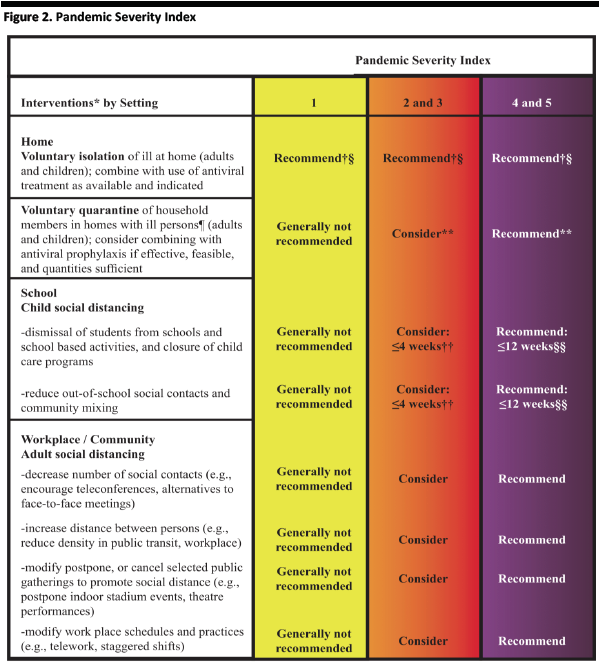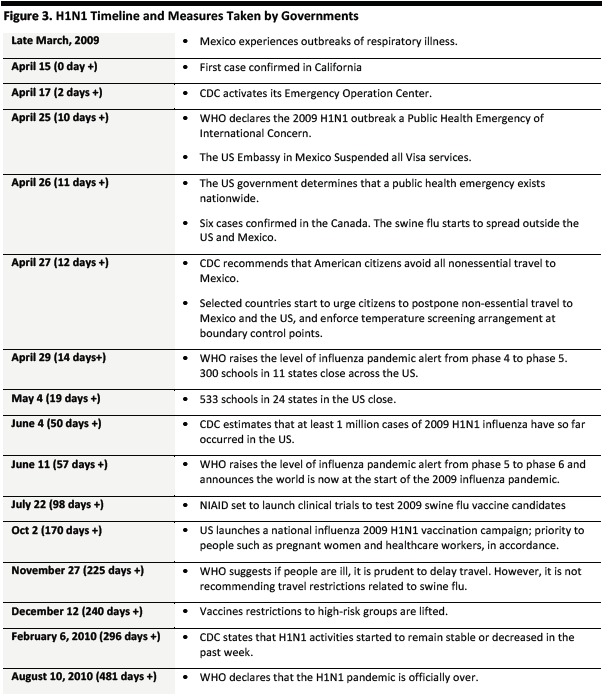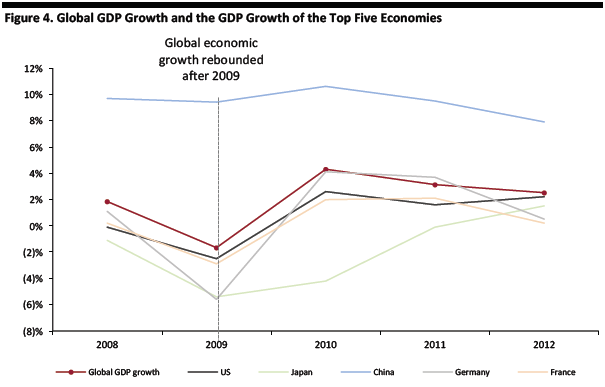
albert Chan
Continuing our Coronavirus Briefing series, we compare the coronavirus with the swine flu pandemic of 2009. We look at the measures taken by governments—particularly the US—to prevent the spread of each.
Comparing the Coronavirus to Swine Flu
COVID-19, also known as coronavirus, has similar symptoms to those exhibited by Influenza A(H1N1) in the 2009 pandemic, such as a dry cough and fever. However, swine flu (as Influenza A(H1N1) is known) was less contagious and had a lower fatality rate than is currently the case for the coronavirus (as shown in figure 1). According to the respective severity of the coronavirus and swine flu, governments have taken different approaches to preventing each from spreading. The coronavirus is on the verge of being declared a pandemic and, ultimately, may have a more meaningful economic and social impact than the swine flu.
[caption id="attachment_103607" align="aligncenter" width="598"] * The reproductive number, also known as R0, measures the transmission potential of a disease. For example, if the R0 for a disease in a population is 2, that means each new case of that disease is expected to produce two new secondary cases. **As of February 13, 2020
* The reproductive number, also known as R0, measures the transmission potential of a disease. For example, if the R0 for a disease in a population is 2, that means each new case of that disease is expected to produce two new secondary cases. **As of February 13, 2020
Source: WHO/CDC/Business Insider/Coresight Research[/caption] Swine flu originated in the US in March 2009, with the first case confirmed on April 15 that year. Referring to the guidance of the CDC (as shown in figure 2), the US government reacted immediately to the outbreak of swine flu by taking several measures, such as the dismissal of students from schools and school-based activities, and encouraging people with flu symptoms and their household members to stay at home (as shown in figure 3). Nonetheless, the disease spread to the rest of the world quickly and became a pandemic. According to researchers from Australia, Hong Kong and Japan, 11–21% of the global population at the time became infected with swine flu between April 2009 and December 2010 (around 700 million to 1,400 million people in total). The CDC estimated that there were approximately 60.8 million cases and 12,468 deaths in the US from April 12, 2009 to April 10, 2010, and the pandemic caused 284,000 deaths globally. [caption id="attachment_103608" align="aligncenter" width="599"] Source: CDC/Coresight Research[/caption]
[caption id="attachment_103609" align="aligncenter" width="602"]
Source: CDC/Coresight Research[/caption]
[caption id="attachment_103609" align="aligncenter" width="602"] Source: CDC/Coresight Research[/caption]
Swine Flu’s Impact on the Global Economy
The subprime financial crisis that started in 2007 had sent many developed regions and countries into recession. It is therefore hard to quantify the short-term impact of the swine flu pandemic on each country; many key economic indicators—such as quarterly GDP growth, total value of retail trade, unemployment rates and Consumer Sentiment Index—were affected by the economic recession.
However, when we look at the global economic growth in the long term and the growth of the top five economies by GDP at the time (as in figure 4), we find that they all started to recover from 2009. We believe that the long-term impact of swine flu was mild, and the fiscal and monetary measures taken by local governments helped the rebound.
However, compared to 11 years ago, the world is now much more connected, so the impact of the coronavirus compared to swine flu could be much greater. If the coronavirus outbreak becomes a pandemic that lasts for a longer time than swine flu and freezes travel and supply chains between countries, it will likely represent a serious threat to global economic growth in the long term. Governments around the world have therefore been actively implementing measures to prevent the coronavirus from becoming another global pandemic.
[caption id="attachment_103610" align="aligncenter" width="560"]
Source: CDC/Coresight Research[/caption]
Swine Flu’s Impact on the Global Economy
The subprime financial crisis that started in 2007 had sent many developed regions and countries into recession. It is therefore hard to quantify the short-term impact of the swine flu pandemic on each country; many key economic indicators—such as quarterly GDP growth, total value of retail trade, unemployment rates and Consumer Sentiment Index—were affected by the economic recession.
However, when we look at the global economic growth in the long term and the growth of the top five economies by GDP at the time (as in figure 4), we find that they all started to recover from 2009. We believe that the long-term impact of swine flu was mild, and the fiscal and monetary measures taken by local governments helped the rebound.
However, compared to 11 years ago, the world is now much more connected, so the impact of the coronavirus compared to swine flu could be much greater. If the coronavirus outbreak becomes a pandemic that lasts for a longer time than swine flu and freezes travel and supply chains between countries, it will likely represent a serious threat to global economic growth in the long term. Governments around the world have therefore been actively implementing measures to prevent the coronavirus from becoming another global pandemic.
[caption id="attachment_103610" align="aligncenter" width="560"] Source: World Bank/Statista/Coresight Research[/caption]
Source: World Bank/Statista/Coresight Research[/caption]
 * The reproductive number, also known as R0, measures the transmission potential of a disease. For example, if the R0 for a disease in a population is 2, that means each new case of that disease is expected to produce two new secondary cases. **As of February 13, 2020
* The reproductive number, also known as R0, measures the transmission potential of a disease. For example, if the R0 for a disease in a population is 2, that means each new case of that disease is expected to produce two new secondary cases. **As of February 13, 2020Source: WHO/CDC/Business Insider/Coresight Research[/caption] Swine flu originated in the US in March 2009, with the first case confirmed on April 15 that year. Referring to the guidance of the CDC (as shown in figure 2), the US government reacted immediately to the outbreak of swine flu by taking several measures, such as the dismissal of students from schools and school-based activities, and encouraging people with flu symptoms and their household members to stay at home (as shown in figure 3). Nonetheless, the disease spread to the rest of the world quickly and became a pandemic. According to researchers from Australia, Hong Kong and Japan, 11–21% of the global population at the time became infected with swine flu between April 2009 and December 2010 (around 700 million to 1,400 million people in total). The CDC estimated that there were approximately 60.8 million cases and 12,468 deaths in the US from April 12, 2009 to April 10, 2010, and the pandemic caused 284,000 deaths globally. [caption id="attachment_103608" align="aligncenter" width="599"]
 Source: CDC/Coresight Research[/caption]
[caption id="attachment_103609" align="aligncenter" width="602"]
Source: CDC/Coresight Research[/caption]
[caption id="attachment_103609" align="aligncenter" width="602"] Source: CDC/Coresight Research[/caption]
Swine Flu’s Impact on the Global Economy
The subprime financial crisis that started in 2007 had sent many developed regions and countries into recession. It is therefore hard to quantify the short-term impact of the swine flu pandemic on each country; many key economic indicators—such as quarterly GDP growth, total value of retail trade, unemployment rates and Consumer Sentiment Index—were affected by the economic recession.
However, when we look at the global economic growth in the long term and the growth of the top five economies by GDP at the time (as in figure 4), we find that they all started to recover from 2009. We believe that the long-term impact of swine flu was mild, and the fiscal and monetary measures taken by local governments helped the rebound.
However, compared to 11 years ago, the world is now much more connected, so the impact of the coronavirus compared to swine flu could be much greater. If the coronavirus outbreak becomes a pandemic that lasts for a longer time than swine flu and freezes travel and supply chains between countries, it will likely represent a serious threat to global economic growth in the long term. Governments around the world have therefore been actively implementing measures to prevent the coronavirus from becoming another global pandemic.
[caption id="attachment_103610" align="aligncenter" width="560"]
Source: CDC/Coresight Research[/caption]
Swine Flu’s Impact on the Global Economy
The subprime financial crisis that started in 2007 had sent many developed regions and countries into recession. It is therefore hard to quantify the short-term impact of the swine flu pandemic on each country; many key economic indicators—such as quarterly GDP growth, total value of retail trade, unemployment rates and Consumer Sentiment Index—were affected by the economic recession.
However, when we look at the global economic growth in the long term and the growth of the top five economies by GDP at the time (as in figure 4), we find that they all started to recover from 2009. We believe that the long-term impact of swine flu was mild, and the fiscal and monetary measures taken by local governments helped the rebound.
However, compared to 11 years ago, the world is now much more connected, so the impact of the coronavirus compared to swine flu could be much greater. If the coronavirus outbreak becomes a pandemic that lasts for a longer time than swine flu and freezes travel and supply chains between countries, it will likely represent a serious threat to global economic growth in the long term. Governments around the world have therefore been actively implementing measures to prevent the coronavirus from becoming another global pandemic.
[caption id="attachment_103610" align="aligncenter" width="560"] Source: World Bank/Statista/Coresight Research[/caption]
Source: World Bank/Statista/Coresight Research[/caption]